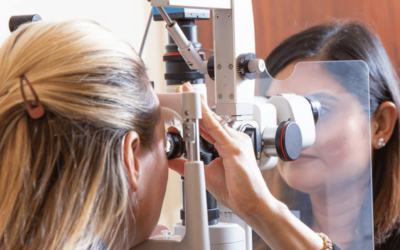Are you over 40 and finding it harder to read small print or focus on things up close? If so, you might be dealing with presbyopia, an age-related eye condition. Presbyopia occurs when the lens in our eye gradually becomes less flexible, making it difficult to focus on close objects. Presbyopia typically becomes noticeable around age 40 when people start to have trouble reading small print, seeing items up close, or doing close work. Other symptoms include headaches, eye strain, and fatigue.
Presbyopia is a natural part of aging, but there are options to manage this condition. In this blog, we’ll share some tips for managing presbyopia to help you see clearly and comfortably.
Bifocal and progressive lenses
Managing presbyopia often involves the use of corrective lenses, and two popular options for addressing this condition are bifocal and progressive lenses. Bifocal lenses have distinct sections with different optical powers. Typically, the upper portion of the lens is designed for distance vision, while the lower portion has a stronger power for near vision. This visible separation is known as a “bifocal line.” Bifocal lenses allow individuals to easily switch their focus between distant and close objects by adjusting their gaze.
In contrast, progressive lenses provide a smooth and seamless transition between multiple distances. Unlike bifocal lenses, which have a distinct line separating the distance and near-vision areas, progressive lenses offer a gradual change in prescription from the top of the lens to the bottom. This provides a more natural and comfortable vision experience, particularly for those who require vision correction for intermediate distances as well.
Contact lenses
If you prefer not to wear glasses, contact lenses may be a good option for managing presbyopia. Multifocal contact lenses have different zones in the lens that allow you to see clearly at different distances. Monovision contact lenses correct one eye for distance vision and the other eye for close-up vision. Your eye doctor can help you decide which type of contact lens is right for you.
Adjust lighting
Proper lighting can make a big difference in managing presbyopia. Dim lighting can make it difficult to focus on objects up close, causing eye strain and discomfort. Bright lighting can help alleviate this strain and improve vision. Consider adding task lighting to your workspace or using a brighter light bulb in your reading lamp. Avoid glare from electronic devices by adjusting screen brightness or positioning them away from light sources.
Awareness and regular check-ups
Lastly, being aware of any vision changes and getting regular eye exams can help manage presbyopia. If you notice changes in your vision or are having difficulty seeing at close range, make an appointment with your eye doctor. Regular eye exams can help detect presbyopia and other eye conditions early on, making treatment much easier.
Presbyopia affects nearly everyone as they age, but it doesn’t have to interfere with your daily life. By following the tips above, you can manage your presbyopia and continue to enjoy comfortable, clear vision! Contact us today to schedule an eye exam at Vision Center LTD in Shelton or Waterbury Eye Associates in Waterbury and learn how we can help you manage presbyopia and other eye conditions.



